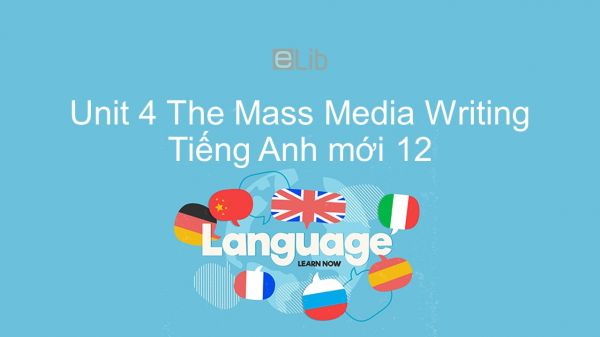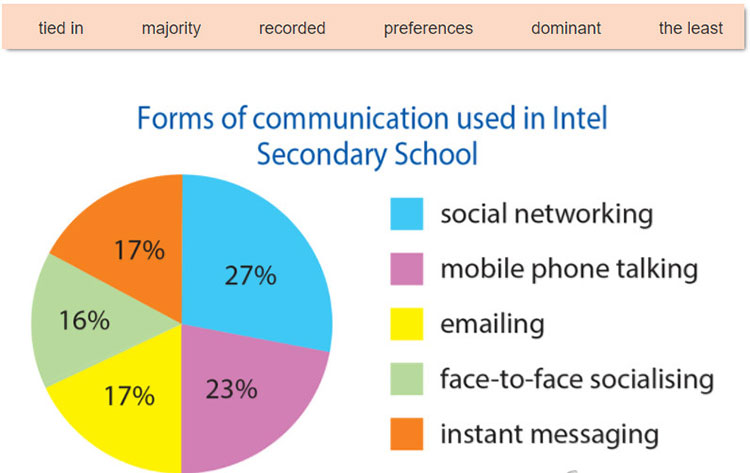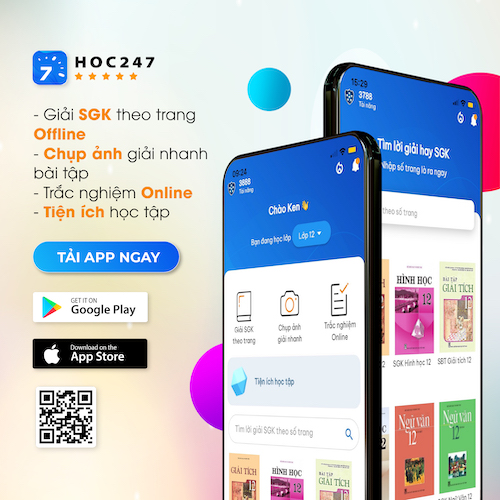Unit 4 lớp 12: The Mass Media - Writing
Bài học Unit 4 Tiếng Anh lớp 12 mới phần Writing cung cấp cho các em cách phân tích biểu đồ hình tròn và cách viết đoạn văn miêu tả việc sử dụng nguồn tài nguyên trực tuyến. Mời các em cùng tham khảo!
Mục lục nội dung

Unit 4 lớp 12: The Mass Media - Writing
Describing a pie chart showing the use of online resources (Mô tả biểu đồ hình tròn thể hiện việc sử dụng nguồn tài nguyên trực tuyến)
1. Task 1 Unit 4 lớp 12 Writing
Work in pairs. Discuss the difference between a graph and a chart; and how to describe a pie chart. (Làm việc theo cặp. Thảo luận về sự khác biệt giữa một đồ thị và biểu đồ; và làm thế nào để mô tả biểu đồ hình tròn.)
Guide to answer
- Charts and graphs represent a series of data but they are different from each other. Graphs are mainly used to represent variation in values over a period of time. Charts are used to give information about the frequency of different quantities in a single pictorial representation.
- To describe a pie chart we should specify the information (content) and proportion of each segment, which can be measured in percentages (%) or fractions (e.g. one-third, a quarter).
Tạm dịch
- Biểu đồ và đồ thị đại diện cho một loạt dữ liệu nhưng chúng khác với nhau. Đồ thị được sử dụng chủ yếu để biểu diễn biến thể giá trị trong một khoảng thời gian. Các biểu đồ được sử dụng để cung cấp thông tin về tần suất các số lượng khác nhau trong một hình ảnh duy nhất.
- Để mô tả biểu đồ hình tròn, chúng ta cần chỉ định thông tin (nội dung) và tỷ lệ của mỗi phân khúc, có thể được đo bằng phần trăm (%) hoặc phân số (ví dụ: một phần ba, một phần tư).
2. Task 2 Unit 4 lớp 12 Writing
The pie chart below illustrates the forms of communication used by students in Intel Secondary School. Complete the description with the words in the box. (Biểu đồ hình tròn dưới đây minh họa các hình thức truyền thông được sử dụng bởi các sinh viên trong trường Trung học Intel. Hoàn thành các mô tả với các từ trong hộp.)

The pie chart shows the preferred forms of communication recorded in a survey carried out in Intel Secondary School in August 2014. Following is a brief description of the students’ (1) preferences. Social networking is (2) recorded as the most preferred form of communication with a (3) majority of 27%. Mobile phone ranks the second at 23%. Emailing is closely (4) tied in with instant messaging at 17% each. The least is face-to-face socialising, which is given 1% less than emailing and instant messaging.Guide to answer
To conclude, the (5) dominant mode of communication for the students at Intel Secondary School is social networking. Of all the other forms – mobile phone talking, emailing, face-to-face socialising and instant messaging – students use face-to-face socialising (6) the least.
Tạm dịch
Biểu đồ tròn cho thấy các hình thức giao tiếp được ưa thích được ghi lại trong một cuộc khảo sát được thực hiện tại Trường Trung học Intel vào tháng 8 năm 2014. Dưới đây là một mô tả ngắn gọn về sở thích của học sinh. Mạng xã hội là được ghi nhận là hình thức giao tiếp được ưa thích nhất với phần lớn là 27%. Điện thoại di động đứng thứ hai ở mức 23%. Gửi email được ràng buộc chặt chẽ với chặt chẽ với tin nhắn tức thời với mức 17% mỗi. Ít nhất là đối mặt với xã hội trực tiếp, nó ít hơn 1% so với gửi email và nhắn tin tức thì.
Để kết luận, phương thức truyền thông chiếm ưu thế với học sinh của Trường Trung học Intel là mạng xã hội. Trong tất cả các hình thức khác - nói chuyện điện thoại di động, gửi email, gặp mặt trực tiếp và tin nhắn tức thì - học sinh sử dụng giao tiếp xã hội trực tiếp là ít nhất.
3. Task 3 Unit 4 lớp 12 Writing
Study the pie chart and write a paragraph of 130-160 words to describe it. (Nghiên cứu các biểu đồ hình tròn và viết một đoạn 130-160 từ để mô tả nó.)
Guide to answer
The pie chart shows students' preferred online resources recorded in a survey carried out at Intel Secondary School Library in 2014. Following is a brief description of the students'preferences.
We can see that a majority of students played interactive games, which rank the first at 30%. Fiction e-books line in the second at 20% and are at 10% less than interactive games. Online magazines rank the third at 18% while non-fiction e-books account for 15%. Online dictionaries are the fifth library resource at 11%. Only a minority of students, or 6%, used science
journals, which is the least popular of all resources, and used fivefold less than the most preferred resource, interactive games.
To conclude, the dominant form of online resources used by the students at Intel Secondary School Library is interactive games. Of all the other resources - fiction e-books, online magazines, non-fiction e-books, online dictionaries and science journals - students used science journals the least.
Tạm dịch
Biểu đồ tròn cho biết các tài nguyên trực tuyến được ưa thích của học sinh được ghi lại trong một cuộc khảo sát được thực hiện tại Thư viện Trường Trung học Intel vào năm 2014. Dưới đây là một mô tả ngắn gọn về các sự thay đổi của học sinh.
Chúng ta có thể thấy rằng đa số học sinh chơi trò chơi tương tác, xếp hạng đầu tiên là 30%. Sách điện tử viễn tưởng là thứ hai ở mức 20%, và thấp hơn 10% so với các trò chơi tương tác. Tạp chí trực tuyến xếp hạng thứ ba là 18% trong khi sách điện tử phi viễn tưởng chiếm 15%. Từ điển trực tuyến là tài nguyên thư viện thứ năm ở mức 11%. Chỉ có một số ít sinh viên, hay 6%, sử dụng khoa học các tạp chí, ít phổ biến nhất trong tất cả các nguồn lực, và được sử dụng ít hơn 5 lần so với các tài nguyên ưa thích nhất - các trò chơi tương tác.
Để kết luận, hình thức xếp hạng đầu của tài nguyên trực tuyến được sử dụng bởi các học sinh tại Thư viện Trường Trung học Intel là trò chơi tương tác. Trong tất cả các tài nguyên khác - sách điện tử viễn tưởng, tạp chí trực tuyến, sách điện tử phi viễn tưởng, từ điển trực tuyến và tạp chí khoa học - học sinh sử dụng tạp chí khoa học ít nhất.
4. Practice
Choose the best answer
Question 1: You will never eat there at the weekend unless you have made a reservation.
A. Let’s make reservation at the weekend to be due of eating there
B. You should have made a reservation if you expected to eat there at the weekend.
C. It is only possible for you to eat there at the weekend if you reserve a table in advance.
D. You may not be able to eat there if you don’t reserve a table at the weekend on purpose.
Question 2: Only Mary scored high enough to pass this test.
A. Mary was the only person to pass this test.
B. Only on this test was Mary’s score high enough.
C. Mary’s score was barely enough to pass.
D. Mary only passed this test because she scored higher than the others.
Question 3: The demand was so great. They had to reprint the book immediately.
A. So great was the demand that they had to reprint the book immediately.
B. The book would be reprinted immediately since the demand was great.
C. They demanded to reprint the book immediately.
D. They demanded that the book be reprinted immediately.
Question 4: He did not work hard. He failed the exam.
A. Unless he had worked hard, he would have failed the exam.
B. Even though he failed the exam, he didn’t work hard.
C. If he had worked hard, he would have passed the exam.
D. However hard he worked, he failed the exam.
Question 5: The horror film didn't come up to our expectations.
A. The horror film fell short of our expectations.
B. We expected the horror film to end more abruptly.
C. We expected the horror film to be more boring.
D. The horror film was as good as we expected.
Question 6: No sooner had I turned on my new PC than there was a strange noise.
A. As soon as there was a strange noise, I turned on my new PC.
B. Scarcely had I turned on my new PC when there was a strange noise.
C. Hardly I had turned on my new PC, there was a strange noise.
D. I had hardly turned on my new PC than there was a strange noise.
Question 7: By the time Pete telephoned me, I had already finished updating my social networking profile.
A. Pete telephoned me while I was updating my social networking profile.
B. Pete telephoned me after I had already finished updating my social networking profile.
C. Hardly I had finished updating my social networking profile when Pete telephoned me.
D. When Pete telephoned me, I finished updating my social networking profile.
Question 8: It was the first time she had ever seen such a moving documentary
A. She had never seen a moving documentary before.
B. She had seen such a moving documentary for a long time.
C. She had never seen a more moving documentary than this before.
D. The first time she saw such a moving documentary was a long time ago.
5. Conclusion
Kết thúc bài học Unit 4 Tiếng Anh Lớp 12 mới – Writing, các em cần nắm cách phân tích biểu đồ hình tròn, viết đoạn văn miêu tả về nó và ghi nhớ các từ vựng
- represent /ˌreprɪˈzent/ thể hiện, đại diện
- describe /dɪˈskraɪb/ diễn tả, mô tả
- preference /ˈprefrəns/ sở thích, yêu thích
- interactive /ˌɪntərˈæktɪv/ tương tác
Tham khảo thêm
- doc Unit 4 lớp 12: The Mass Media - Getting Started
- doc Unit 4 lớp 12: The Mass Media - Language
- doc Unit 4 lớp 12: The Mass Media - Reading
- doc Unit 4 lớp 12: The Mass Media - Speaking
- doc Unit 4 lớp 12: The Mass Media - Listening
- doc Unit 4 lớp 12: The Mass Media - Communication and Culture
- doc Unit 4 lớp 12: The Mass Media - Looking Back
- doc Unit 4 lớp 12: The Mass Media - Project




